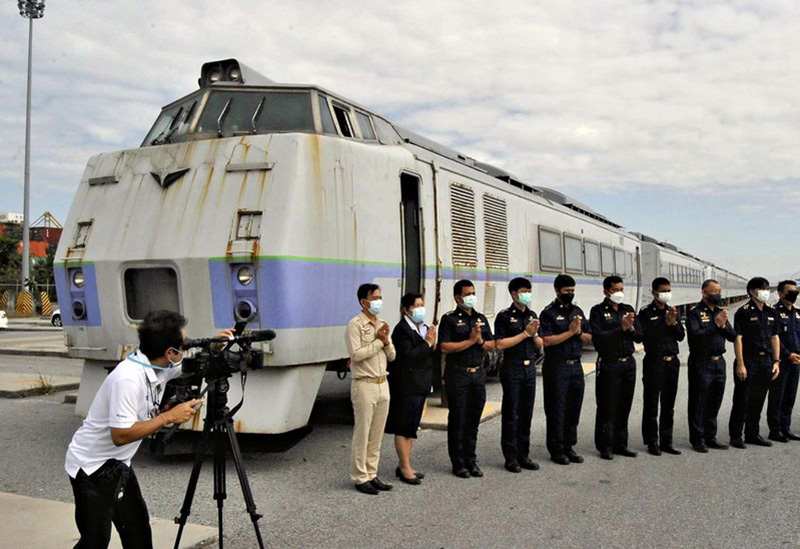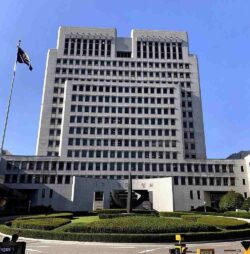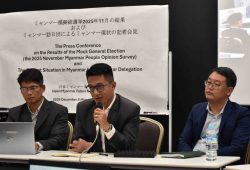
State Railway of Thailand employees pose in front of a diesel train used by JR Hokkaido at Laem Chabang Port in central Thailand in December.
14:56 JST, January 23, 2022
BANGKOK — There is a trend in Southeast Asian nations toward purchasing new train carriages instead of introducing secondhand carriages from Japan, as their economies continue to grow.
Used train cars manufactured in Japan are popular in Southeast Asian countries, but there has been controversy over using such carriages due to transportation costs and other factors.
While this trend is prompting concern among Japanese railway companies over how to scrap their railroad cars, the move toward new cars will likely bring about a significant business opportunity for train car manufacturers.
‘Scrap metal’
In early December, a retired diesel train from Hokkaido Railway Co. (JR Hokkaido) arrived at a port in Thailand. The distinctive front view of the train, which was used for the limited express Okhotsk, has been loved by train enthusiasts in Japan. The State Railway of Thailand is planning to remodel it and use it as a sightseeing train.
According to the Bangkok Post, the Thai railway paid about 42.5 million baht (about ¥147 million) for transportation of the 17 train cars and other related costs.
This payment has caused controversy in the country. Those in favor of using the secondhand train cars expressed their expectation that the made-in-Japan cars would be of a high quality and well maintained. However, a number of people claimed that it was too costly to introduce the almost 40-year-old train — described as “scrap metal” on the internet.
There are similar situations involving secondhand Japanese carriages in other countries. In Vietnam, the government announced at the end of November that it is opposed to Vietnam Railways’ plan to import 37 diesel trains from East Japan Railway Co. (JR East), citing that they are too old for their standards, local media reported.
Economic growth
In Southeast Asian countries, used Japanese railcars have been in high demand since around 2000. JR East provided more than 800 train cars to Indonesia between 2013 and 2020.
Secondhand cars have been offered to railroad companies in countries such as Myanmar, Thailand and the Philippines. Before the coronavirus pandemic, many railroad fans from Japan visited such countries to see the trains.
In recent years, the public in such countries has been growing more critical of buying used carriages, partly because their economic growth has made it easier for them to afford new ones.
Problems over maintenance and management are also driving the growing trend toward new carriages.
“Train cars are almost custom-made, and thus it takes a lot of time to order parts for such used cars. New railcars come with generous warranties from the manufacturer,” said Koichi Kawamura of the Institute of Developing Economies of the Japan External Trade Organization, who is an expert on railroads in Southeast Asia.
In some countries, he said, some used train cars have been abandoned due to lack of maintenance.
If the avoidance of secondhand train cars accelerates in Southeast Asia, the “second homeland” of Japanese rolling stock, Japanese railroad companies could face increased costs.
The average cost of scrapping a conventional train car is said to be around ¥2 million to ¥3 million, according to a major railroad company.
Scrapping a large number of cars would further deteriorate business performance, which was already worsen by the COVID-19 disaster.
Competition
Yet the recent trend of seeking new cars could bring new business opportunities for manufacturers. Competition has begun among Japanese, European, U.S. and Chinese manufacturers in anticipation of such demand.
The Purple Line, an urban railroad in Bangkok that opened in 2016, introduced new cars from Japan Transport Engineering Co., a subsidiary of JR East.
In October last year, the company began shipments to an urban railroad in Manila.
Nippon Sharyo Ltd., which is under the umbrella of Central Japan Railway Co. (JR Tokai), and Hitachi Ltd. have also had their new cars adopted in various countries.
“Used rolling stock will remain available only on some lines, including conventional lines,” Kawamura said. He believes that used train cars will gradually be replaced by new ones.
"World" POPULAR ARTICLE
-

8 Japanese Nationals Stranded on Indonesia’s Sumatra Island
-

U.S. Senate Resolution Backs Japan, Condemns China’s Pressure
-

China to Impose Sanctions on Shigeru Iwasaki, Former Head of Japan’s Self-Defense Forces, Who Serves as Adviser to Taiwan’s Executive Branch
-

South Korea’s Top Court Dismisses Nippon Steel Appeal in Lawsuit over Requisitioned Worker
-

75% of Myanmar People Reject Army’s Political Involvement, According to Survey Conducted by Aid Organization
JN ACCESS RANKING
-

Tokyo Economic Security Forum to Hold Inaugural Meeting Amid Tense Global Environment
-

Keidanren Chairman Yoshinobu Tsutsui Visits Kashiwazaki-Kariwa Nuclear Power Plant; Inspects New Emergency Safety System
-

Imports of Rare Earths from China Facing Delays, May Be Caused by Deterioration of Japan-China Relations
-

University of Tokyo Professor Discusses Japanese Economic Security in Interview Ahead of Forum
-

Japan Pulls out of Vietnam Nuclear Project, Complicating Hanoi’s Power Plans





















